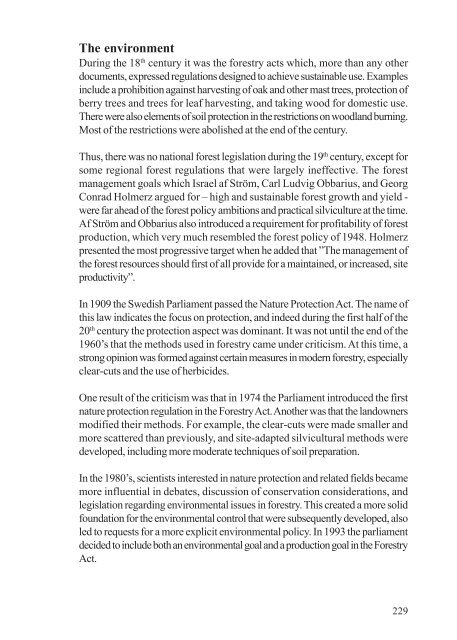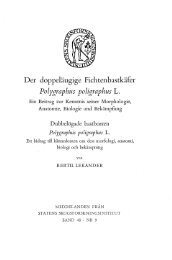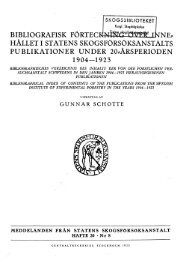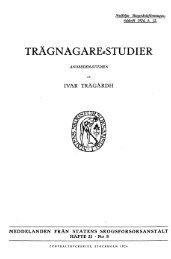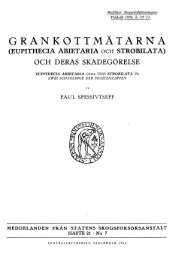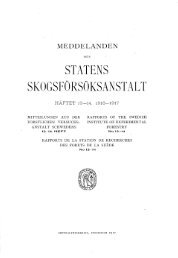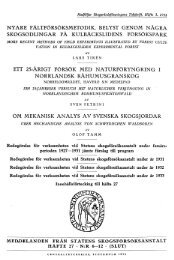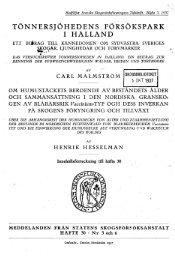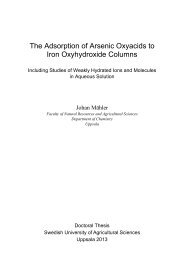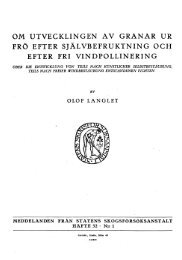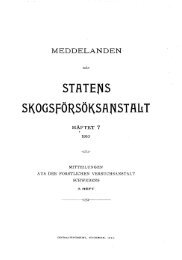Ekologi, skog och miljö - Epsilon Open Archive - Sveriges ...
Ekologi, skog och miljö - Epsilon Open Archive - Sveriges ...
Ekologi, skog och miljö - Epsilon Open Archive - Sveriges ...
You also want an ePaper? Increase the reach of your titles
YUMPU automatically turns print PDFs into web optimized ePapers that Google loves.
The environment<br />
During the 18 th century it was the forestry acts which, more than any other<br />
documents, expressed regulations designed to achieve sustainable use. Examples<br />
include a prohibition against harvesting of oak and other mast trees, protection of<br />
berry trees and trees for leaf harvesting, and taking wood for domestic use.<br />
There were also elements of soil protection in the restrictions on woodland burning.<br />
Most of the restrictions were abolished at the end of the century.<br />
Thus, there was no national forest legislation during the 19 th century, except for<br />
some regional forest regulations that were largely ineffective. The forest<br />
management goals which Israel af Ström, Carl Ludvig Obbarius, and Georg<br />
Conrad Holmerz argued for – high and sustainable forest growth and yield -<br />
were far ahead of the forest policy ambitions and practical silviculture at the time.<br />
Af Ström and Obbarius also introduced a requirement for profitability of forest<br />
production, which very much resembled the forest policy of 1948. Holmerz<br />
presented the most progressive target when he added that ”The management of<br />
the forest resources should first of all provide for a maintained, or increased, site<br />
productivity”.<br />
In 1909 the Swedish Parliament passed the Nature Protection Act. The name of<br />
this law indicates the focus on protection, and indeed during the first half of the<br />
20 th century the protection aspect was dominant. It was not until the end of the<br />
1960’s that the methods used in forestry came under criticism. At this time, a<br />
strong opinion was formed against certain measures in modern forestry, especially<br />
clear-cuts and the use of herbicides.<br />
One result of the criticism was that in 1974 the Parliament introduced the first<br />
nature protection regulation in the Forestry Act. Another was that the landowners<br />
modified their methods. For example, the clear-cuts were made smaller and<br />
more scattered than previously, and site-adapted silvicultural methods were<br />
developed, including more moderate techniques of soil preparation.<br />
In the 1980’s, scientists interested in nature protection and related fields became<br />
more influential in debates, discussion of conservation considerations, and<br />
legislation regarding environmental issues in forestry. This created a more solid<br />
foundation for the environmental control that were subsequently developed, also<br />
led to requests for a more explicit environmental policy. In 1993 the parliament<br />
decided to include both an environmental goal and a production goal in the Forestry<br />
Act.<br />
229


